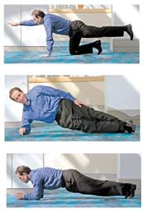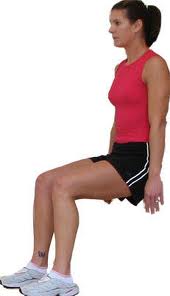 Running has so many amazing health benefits – it fills us with high energy endorphins, keeps us lean and mean, makes our heart stronger, and it’s even meditative for some. That being said , runners have the highest incidence of chronic injuries out of any group of athletes, including contact sport athletes. Why? The constant repetitive strain that the running motion has on the body can and will take its tole over time and injury will eventually ensue; that is, unless one trains their body to be able handle this strain.
Running has so many amazing health benefits – it fills us with high energy endorphins, keeps us lean and mean, makes our heart stronger, and it’s even meditative for some. That being said , runners have the highest incidence of chronic injuries out of any group of athletes, including contact sport athletes. Why? The constant repetitive strain that the running motion has on the body can and will take its tole over time and injury will eventually ensue; that is, unless one trains their body to be able handle this strain.
Yes, that means injury can be avoided! By strengthening the muscles, ligaments, tendons and bones that are needed for the repetitive motion of running, we are lubricating and protecting them from wear and tear. Muscle contractions stimulate not only the muscles themselves but also make your tendons and ligaments stronger, as well as increase bone density. So proper targeted resistance training can and will help keep you running longer, more efficiently, and at a faster pace, if that’s what you’re looking for. Win win! Track, hill and stair workouts are also excellent forms of training, especially if you’re looking to improve your time, from a performance standpoint.
Below I share some important points. These include resistance training, track workouts to improve speed, and cross training to be able to strengthen the body through ways that simply running cannot do alone. Wether you’re a recreational runner (yes overuse injuries can affect you eventually as well) or a running junkie, these fitness tips will help you on your way to a long lasting injury free running career.
Strength Training exercises to address:
- Bilateral as well as unilateral (working one side at a time) exercises, to address any muscle imbalances. For example Bulgarian lunges.
- Functional movements – squats, deadlifts, lunges @ different angles
- Movements specific to running – calf raises, heel raises, butt kicks, high knees.
- Isometric exercises, to keep body stable and help build your lactic acid tolerance – planks, bridges, wall sit
- Pick 3-5 exercises from those listed above. Do 2-3 sets of each. 10-12 reps of each. Don’t be afraid to lift heavy. That will make you stronger!
Key muscles to address (that often get neglected):
- Core: The muscles of your torso that support your every move – abs, obliques, low back, hip flexors. This is key, even before you address any strength training in the legs.
- Hips: A majority of running injuries are caused by weak hips—a major problem area for runners who sit for most of the day. Foam rolling the hips is a great option for muscle recovery and injury prevention as well.
- Glutes: When we run, the glutes extend our hip, propel us forward, and keep our legs, pelvis, and torso aligned. When engaged, they also help prevent strain on the lower back. Glutes don’t fire or engage as naturally as hamstrings, quadriceps, and calves, and as a result are usually disproportionately weaker than those muscles. For that reason, incorporating more isolating exercises such as glute bridges and single leg Romanian deadlifts are also important.
Cross training for running
Spinning / Indoor cycling : Use spinning intervals to reinforce brisk leg turnover and get a rigorous cardio workout without the impact stress on your joints.
Swimming: Whether you run or swim, building upper-body strength helps you hold your form even when you tire in the latter part of a workout or race
Stairs: I really like using stairs as cross training for running. Unlike swimming or cycling, doing stairs uses the same muscle groups as running, and in the same running-specific motion. It is especially beneficial for hill training as it follows a similar muscle action.
- To improve quick leg turnover run single steps as fast as you can.
- To improve stride length and power, work on exaggerated strides by skipping steps or even running up stadium benches (if not too high – be careful)
Track workout
This type of workout is especially beneficial for improving your 5k times…and in turn allows you to start picking up the pace on longer runs. Your running will become less laboursome & more efficient.
On a 400m track: (*First start with the warm-up drill listed below.)
- 2 k jog (5 laps easy pace).
- 4 x 400m hard but smooth. After each 400m sprint (1 full lap), jog half a lap and walk the remaining half lap. Do this 4 times.
- Goal is to keep an even or negative split for each lap (second 200m at least as fast as first).
- Work up to 8 x 400m
- Make sure you do the warm up portion & stretch after this workout, especially quads & hams or you’ll feel the soreness for days!
*Warm-Up Before Track Workout
Take a 30m stretch of land to do 1 length back/forth of each:
- light jog
- high knees jog/walk
- butt kick jog/walk
heel walking - walking on balls of feet
IMPORTANCE OF HYDRATING PROPERLY
3-4 glasses of water every morning upon waking. Throughout 60 minutes. Don’t forget you’ve been without water for 8 hours or so…your body needs it! Not ice cold either as it’s harder for body to convert it to warmer body temperature, so stick to luke warm water, with lemon if possible.
Don’t take in any extra water /Gatorade on race day that you haven’t taken in training. Try to keep the same routine in training as on race day. You don’t want any nasty surprises (cramps, stitches, heaviness)
ALWAYS REMEMBER
LISTEN TO YOUR BODY! OVERTRAINING IS NOT A MYTH. LAST THING YOU WANT IS FOR ALL YOUR GAINS FROM TRAINING TO BE LOST BECAUSE OF FATIGUE FROM OVERTRAINING!
Most of all: Have fun on your run!
Sample glute and core Exercises for running :
Glutes:
Glute Bridge
- Start with 2 leg (bilateral). Move your way up to 1 leg at a time (unilateral)
- Hold the top of each for 5-10 seconds. Complete 10 reps/leg

2 leg & Single Leg Romanian Deadlift
- Start with 2 legs. Work your way to one leg at a time.
- Hold light dumbbells in each hand. Complete 10 reps/leg


Core:
3 exercises to cover 360° of core:
- Bird dog – hold 10 sec/side
- Side plank – hold 20-30 sec/side
- Front plank – build up to 60 sec
- Repeat 2-3 times
Isolation: (hold each for 1-2 min, building up your time with increased tolerence)
- Planks
- Wall sit

If you’d like more individualized guidance on how to train and improve your strength for running, or for injury prevention, feel free to contact me. I’d love to help you get you in your strongest shape!
Justine


